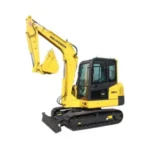Einführung
Pile drivers are essential equipment in construction for driving piles into the ground to provide foundational support for various structures. This comprehensive guide explores the techniques, equipment, and applications of pile driver construction in modern building projects.
Types of Pile Drivers

Hydraulic Pile Drivers
Hydraulic pile drivers utilize hydraulic pressure to drive piles into the ground efficiently. They offer precise control over pile placement and force application, making them suitable for both small and large-scale construction projects.
Diesel Hammer Pile Drivers
Diesel hammer pile drivers use a diesel-powered hammer mechanism to deliver impact energy to drive piles into the ground. They are robust and suitable for driving piles in tough soil conditions.
Components of Pile Driver Equipment
Hammer Assembly
The hammer assembly is the core component of a pile driver, responsible for delivering the necessary impact or pressure to drive the pile into the ground. It includes the hammer head, ram, and associated hydraulic or diesel mechanisms.
Pile Cushion
The pile cushion absorbs the impact energy transferred from the hammer to the pile, reducing stress and preventing damage to the pile during driving.
Operating a Pile Driver
Pre-Operation Checks
Before operating a pile driver, conduct thorough inspections of equipment components, hydraulic systems, and safety features to ensure safe and efficient operation.
Driving Techniques
Effective driving techniques involve controlling the impact force and pile alignment to achieve proper pile penetration and foundation stability.
Factors Influencing Pile Driver Selection
The choice of pile driving technique and equipment depends on several factors:
- Soil Conditions: The type and strength of the soil determine the required pile depth, driving force, and suitable pile driving method.
- Structure Load: The weight and load-bearing requirements of the structure influence the pile size, quantity, and driving depth.
- Environmental Considerations: Noise regulations, vibration concerns, and potential impact on nearby structures may influence the choice of pile driving method.
- Budget and Project Schedule: The cost and duration of pile driving operations play a significant role in equipment selection and project planning.
Common Pile Driving Techniques
Pile drivers employ various techniques to drive piles into the ground:
- Impact Driving: This traditional method uses a hammer to strike the top of the pile, forcing it into the ground.
- Vibratory Driving: This method utilizes a vibrator attached to the pile to create vibrations that liquefy the soil, allowing the pile to sink under its own weight.
- Hydraulic Driving: This method employs a hydraulic ram to push the pile into the ground, applying continuous pressure.
- Sonic Driving: This method utilizes high-frequency sound waves to liquefy the soil, facilitating the pile’s penetration.
Table: Comparison of Hydraulic vs. Diesel Hammer Pile Drivers
| Feature | Hydraulic Pile Driver | Diesel Hammer Pile Driver |
|---|---|---|
| Power Source | Hydraulic pressure | Diesel engine |
| Impact Force Control | Precise control | High impact energy |
| Suitable Soil Conditions | Versatile; suitable for various soils | Tough soil conditions |
| Noise Levels | Lower | Higher |
| Wartung | Requires hydraulic system checks | Requires diesel engine upkeep |
Essential Pile Driver Equipment

Pile drivers encompass a range of equipment, each serving a specific purpose:
- Power Source: The power source provides the energy to drive the piles, ranging from diesel engines to electric motors.
- Driving Mechanism: The driving mechanism transfers the power source’s energy to the pile, including hammers, vibrators, hydraulic rams, or sonic drivers.
- Pile Leader: The pile leader guides the pile into the correct position and alignment during driving.
- Monitoring and Control Systems: Sophisticated monitoring systems track pile movement, driving force, and soil conditions, ensuring safe and efficient operation.
Conclusion: Pile Driver Construction
Pile driver construction is a critical aspect of building foundations for infrastructure projects, offering efficient methods to secure structural stability. Understanding the equipment, techniques, and operational considerations is key to successful pile driving in construction.
FAQ
What are the primary applications of pile driver construction?
Pile drivers are used in construction projects to install foundations for buildings, bridges, dams, and offshore structures where soil conditions require deep or reinforced support.
How do you determine the appropriate pile driver type for a project?
The selection of a pile driver type depends on factors such as soil type, project size, environmental considerations, and the desired level of control over impact force and noise levels.
What safety precautions should be taken when operating a pile driver?
Operators should undergo training, wear appropriate safety gear, conduct pre-operation checks, and follow manufacturer guidelines for safe operation of pile driver equipment.
Can pile driver construction impact nearby structures or the environment?
Efforts are made to mitigate noise and vibration during pile driving to minimize potential impacts on nearby structures and the environment. Environmental assessments and monitoring may be required in sensitive areas.
How does pile driver construction contribute to sustainable building practices?
By providing strong, stable foundations efficiently, pile driver construction supports the longevity and sustainability of infrastructure, reducing long-term maintenance and repair needs.







-150x150.webp)
